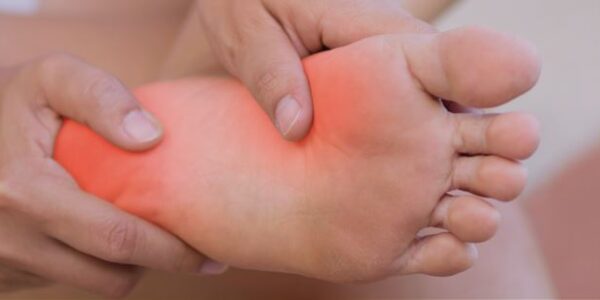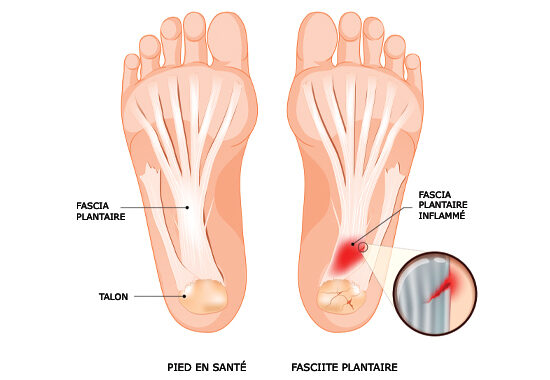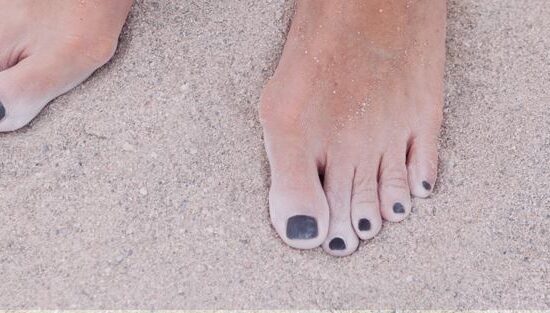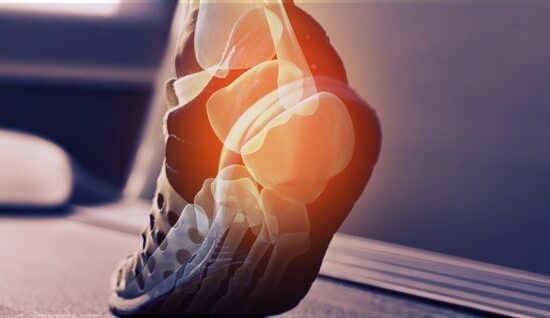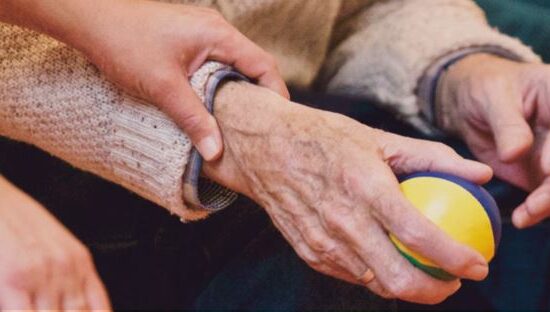Fasciitis can also be caused by other, lesser-known factors. These include reduced muscular flexibility, particularly in the calves, imbalance in leg length and certain inflammatory diseases.
As you can see, there are many possible causes of plantar fasciitis. In the event of symptoms, we can only recommend that you take a step-by-step approach to identifying what’s causing the pain, and that you refrain from straining your tendon as long as the pain is present.
Heel spur syndrome: a common complication
Plantar fasciitis is one of the main causes of heel pain. However, it can be accompanied by another problem: Lenoir’s spur.
Heel Spur (Lenoir’s thorn)syndrome is a bony growth that often forms in reaction to plantar fasciitis. The symptoms are quite similar, but it’s important not to confuse the two conditions.
If your plantar fasciitis is poorly treated or recurs regularly, the micro-tears and inflammation can lead to a build-up of calcium in the heel. Over time, this accumulation will harden into a small spike, hence the term “thorn”.
It should be noted that the thorn itself is not always painful. It’s the rubbing and irritation it causes on the inflamed plantar fascia that generates significant discomfort.
If left untreated, this outgrowth can aggravate plantar fascia damage and complicate recovery.
How is plantar fasciitis diagnosed?
To make a reliable diagnosis, you have two options:
- Consult a healthcare professional
- Carry out a biomechanical assessment
A biomechanical assessment provides a rigorous analysis of your body’s osteo-articular and muscular functioning, both in a static position and in movement.
This examination is generally carried out by an orthotist. It combines a physical and clinical assessment, using advanced imaging technologies to understand how your body works. The aim is to pinpoint any imbalances or abnormalities in your body that could explain what’s causing your plantar fasciitis.
If you’re interested in a biomechanical assessment, Medicus offers this service at all our branches. Don’t hesitate to make an appointment with our orthotists to identify the cause of your plantar fasciitis.
What are the solutions for lasting relief from plantar fasciitis?
Find out below about the various solutions available to you to relieve your pain quickly and avoid any complications.
The use of foot orthotics
In the case of plantar fasciitis, the use of a plantar orthosis can greatly alleviate and limit the onset of plantar fasciitis.
We recommend that you opt for custom-made foot orthotics, to perfectly respect the morphology of your foot. This is more effective and faster than a ready-made orthotic that is not adapted to your foot. In addition to being more effective, custom-made orthoses are much more comfortable to wear daily.
To treat this type of pathology, we add a small pad at heel level to relieve pressure in this area and distribute the load of your weight. The brace acts as a support, helping to relieve symptoms by supporting the arch of the foot and relieving pressure on the heel. It also plays an essential role in controlling the foot during the three phases of stepping: attack, support and propulsion.
Take orthopedic shoes
Wearing orthopedic footwear that respects the anatomy of the foot and provides good support is an excellent solution for reducing pain and the onset of plantar fasciitis.
Nowadays, it’s not unusual to find orthopedic shoes that are pleasant to wear and in line with current fashion trends. The advantage of orthopedic shoes for plantar fasciitis is that they support the foot well and have a thick, comfortable sole that absorbs shocks much more effectively, thus limiting inflammation.
Specific exercises
In addition to appropriate treatment, we advise you to incorporate targeted exercises into your routine to speed up recovery and prevent recurrence.
The aim of these exercises is to stretch the plantar fascia while strengthening the foot muscles and relaxing the posterior chain (calf, Achilles tendon). This will reduce tension on inflamed tissues and restore better mobility.
Our experts have written a dedicated article featuring a selection of stretches for plantar fasciitis. You can easily perform them at home, to act directly on your pain.
Rest
Reducing exertion allows the plantar fascia to heal and limits inflammation. Ideally, reduce high-impact activities (running, jumping) in favor of gentle walking on soft surfaces. Wearing a night splint can keep the foot slightly flexed, preventing the fascia from shortening overnight.
Complementary treatments such as warm footbaths, followed by localized ice application for 10 to 15 minutes, help reduce swelling and pain. In the acute phase, remember to elevate the foot slightly at rest to promote venous drainage and reduce pressure on the fascia.
Finally, a combination of rest and gentle mobilization (without excessive weight-bearing) helps stimulate local circulation and accelerate tissue repair.
Get lasting relief for plantar fasciitis
Tired of heel pain slowing you down with every step? It’s time to take action. In our 20 Medicus branches across Quebec, our orthotists put the expertise they’ve acquired over more than 65 years to work for you.
You can avoid a lot of pain by following a few simple steps: using custom-made foot orthotics, wearing adapted shoes, progressive transitions, and regular stretching.
Above all, don’t wait for pain to take hold. Our orthotists are there to guide you towards optimum relief, with personalized support and solutions tailored to your needs. Read all our tips and articles on preventing foot pain on our blog, or book an appointment with one of our specialists.
Validated by Emmanuel Beauchemin, Clinical Lead at Médicus

